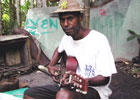
Betelnut Bisnis 2004
Distributed by Filmakers Library, 124 East 40th Street, New York, NY 10016; 202-808-4980
Produced by Andrew Pike
Directed by Chris Owen
VHS, color, 52 min.
College - Adult
Anthropology, Multicultural Studies, Postcolonialism, Sociology
Date Entered: 09/23/2005
Reviewed by Charles Burkart, Head, Audiovisual Library, West Virginia University, Morgantown, WVBetelnut is the forth most used stimulant in the world behind nicotine, alcohol and caffeine. Its use is particularly prevalent in parts of East Africa and Western Asia. The enjoyment and sale of this unusual commodity is the subject of Betelnut Bisnis. As you have probably guessed, “bisnis” is pidgin for business. Most of the film’s dialog is in New Guinea pidgin with English subtitles.
New Guinea is a desperately poor former protectorate of Australia, where many people live barely above the subsistence level. The film’s protagonist, Lucas Kaima, is an impoverished part-time security guard for the National Film Institute near Goroko. Lucas his wife and family live in a small thatched roof hut without electricity or running water. They are not “salary workers” and live hand to mouth.
Demand for betelnut is high in Lucas’ hometown in the Eastern Highlands and good quality betelnut is particularly scarce. Lucas and his wife, Kopa, attempt to make some extra money by selling betelnut from the distant coastal town of Madang. Unfortunately, travel on the dirt roads of New Guinea to the coast is both hazardous and time consuming. Moreover, additional business related problems prevent Lucas from realizing his dream of income from betelnut.
So how do people chew betelnut? They first swab their mouths with lime on a mustard stick, and then they crush the nut on their back teeth. The contents of their mouths are usually not swallowed but spit out leaving the gums a bright red.
From a technical standpoint, the film is well done. Most of the actual photography was done by the writer and director, Australian ex-patriot Chris Owen, who is rarely seen in the film. Color is natural and only saturated in a couple of scenes. Sound is clear and understandable. Editing is interesting and moves the film along nicely. Music is provided by local musicians and is both appropriate and enjoyable. As mentioned before, dialog is in New Guinea pidgin with English subtitles. These subtitles are very legible and easy to read.
Betelnut Bisnis is not an anthropological film, although at times, the film plays like one. The writer/director, Chris Owen, is not a professional anthropologist. The film is more of a personal narrative and human interest story. This leads to the problem of what the film can be used for. Certainly, for Western Pacific viewers it will be of value, and it does present a contemporary view of life in New Guinea that should be of interest to anthropologists, geographers and Post Colonial historians.
However, there were some questions that I wish the film had explored. For instance, is there a connection between betelnut chewing and cancer? One child developed a persistent sore chewing the nut. Furthermore, what did the birds look like that Lucas identified by their songs? How much is a toea or kina worth? Why are the name spellings on the back of the video’s case different than the subtitles? These are all minor criticisms.
In conclusion, I recommend Betelnut Bisnis. It should be purchased for academic collections that specialize in the Western Pacific (Solomon Islands, New Guinea, and Micronesia) materials. It could also be of used in advanced college anthropology classes. It could easily be used with the other New Guinea films recommended in Educational Media Reviews Online: Advertising Missionaries and Colonists for a Day.